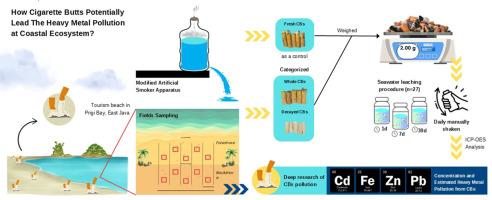沿海环境中烟头的空间分布和重金属浸出评估:来自印度尼西亚普里吉湾的证据
IF 7.7
Q2 ENGINEERING, ENVIRONMENTAL
引用次数: 0
摘要
烟头通常是世界各地的海洋垃圾,这些小而持久的废物含有有毒成分,包括重金属。它们通过金属浸出进入沿海生态系统而构成环境风险,但它们对海洋污染的贡献仍然知之甚少。本研究旨在探讨沿海环境中烟头重金属的空间分布和淋滤规律,并评价其污染潜力。在Prigi湾4个海滩采集烟头,分别进行1、7、30天的海水浸出实验,并进行ICP-OES重金属分析。共收集到608个烟头,以Prigi海滩最多(37%),其次为增戎(31%)、Mutiara(20%)和Karanggongso(12%),各地点间差异有统计学意义(χ²= 85.91,p < 0.05)。所有泳滩的烟头主要分布在后海岸地带,而前海岸地带则较少。全烟头(WCBs)丰度为7 - 29%,而腐烟头(DCBs)丰度为5 - 9%。浸出实验显示出不同的重金属释放模式:Cd在早期快速释放,Fe在第7天出现延迟峰值,Zn随着时间的推移逐渐增加。估计污染值为0.0448 ~ 0.1906µg/m²,Zn为0.0189 ~ 0.0804µg/m²,其中Prigi和Mutiara海滩的污染潜力最大。本研究首次对印尼沿海水域的烟头污染进行了定量评估。研究结果强调烟头是持续存在的重金属来源,为有针对性的沿海废物管理战略提供了重要数据。本文章由计算机程序翻译,如有差异,请以英文原文为准。

Spatial distribution and heavy metal leaching assessment of cigarette butts in coastal environments: Evidence from Prigi Bay, Indonesia
Cigarette butts are commonly found as marine litter worldwide and these small but persistent waste items contain toxic components including heavy metals. They pose environmental risks through metal leaching into coastal ecosystems, yet their contribution to marine pollution remains poorly understood. This study aims to investigate the spatial distribution and heavy metal leaching patterns of cigarette butts and evaluate their contamination potential in coastal environments. Cigarette butts were collected from four beaches in Prigi Bay and subjected to seawater leaching experiments over 1, 7, and 30 days, followed by heavy metal analysis using ICP-OES. A total of 608 cigarette butts were collected, with Prigi Beach showing the highest abundance (37 %), followed by Cengkrong (31 %), Mutiara (20 %), and Karanggongso (12 %) beaches with significant differences among sites (χ² = 85.91, p < 0.05). Cigarette butts were predominantly distributed in backshore zones compared to foreshore zones across all beaches. Whole cigarette butts (WCBs) dominated with abundance ranging 7–29 % compared to decayed cigarette butts (DCBs) at 5–9 %. Leaching experiments revealed distinct heavy metal release patterns: Cd demonstrated rapid early release, Fe exhibited delayed peaks on day 7, and Zn increased progressively over time. Estimated pollution values ranged 0.0448–0.1906 µg/m² for Fe and 0.0189–0.0804 µg/m² for Zn, with Prigi and Mutiara Beaches showing highest contamination potential. This study provides the first quantitative assessment of cigarette butt contamination in Indonesian coastal waters. The findings emphasize cigarette butts as persistent heavy metal sources, contributing essential data for targeted coastal waste management strategies.
求助全文
通过发布文献求助,成功后即可免费获取论文全文。
去求助
来源期刊

Journal of hazardous materials advances
Environmental Engineering
CiteScore
4.80
自引率
0.00%
发文量
0
审稿时长
50 days
 求助内容:
求助内容: 应助结果提醒方式:
应助结果提醒方式:


